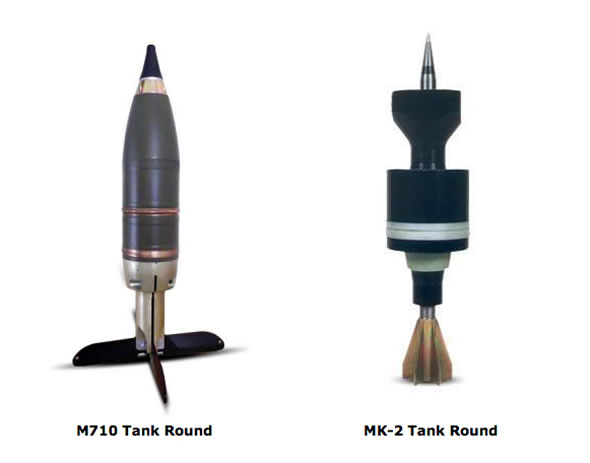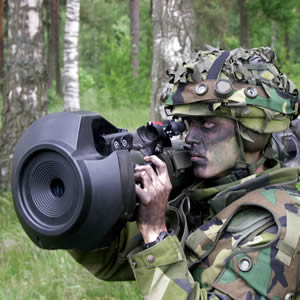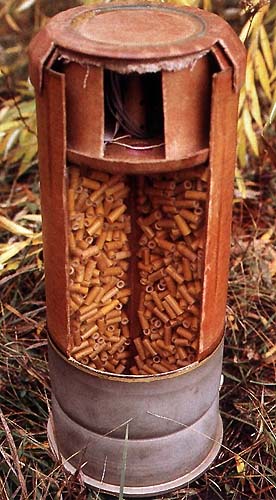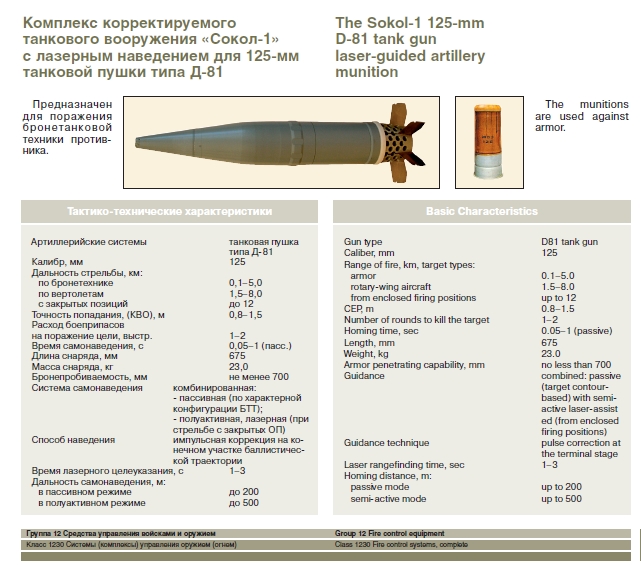AT Round penetration estimates:
(please be aware there is a good margin of error around any of these figures)
Israeli/Chinese Type-IIM (new) 125mm 600mm at 2km
Chinese Type-II 125mm 550mm at 2km
Pakistani Niaza 125mm DU 550mm at 2km
Israeli M711 (Romanian CL3254) 125mm tungsten 560mm at 2km (1995) (20:1 L/D) (also imported by India in 1999)
Chinese/Pak (old) 125mm tungsten 460-480mm at 2km (1993)
Ukraine 125mm Vitiaz round 760mm at 2km (2002)
Russian 125mm BM-42M "Lekalo"? tungsten 600-650mm at 2km (200?)
Russian 125mm BM-46 "Svinets" DU 650mm at 2km (1991) (22:1 L/D)
Russian 125mm BM-42 "Mango" tungsten alloy 520mm at 2km (1986) (16:1 L/D)
Russian 125mm BM-32 "Vant" DU 560mm at 2km (1985) (13:1 L/D)
Russian 125mm BM-29 DU 470mm at 2km (1982) (12:1 L/D)
Russian 125mm BM-26 "Hope" (1983) tungsten alloy 450mm at 2km (extended BM-22 13:1 L/D)
Russian 125mm BM-22 "HairPin" (1976) tungsten 430mm at 2km (most common round in late 1970s/early 1980s)
Russian 125mm BM-17 (1972) steel 310mm at 2km (simplified export BM-15)
Russian 125mm BM-15/Yugo M88 tungsten carbide slug (1972) 340mm at 2km (version of BM-12 with extended projectile)
Russian 125mm BM-12 tungsten carbide slug (1968) 315mm at 2km
Russian 125mm BM-9 steel (1962) 290mm at 2km
Russian 125mm BK-12 HEAT (1962) 420mm at all ranges
Russian 125mm BK-18/21 HEAT (1980) 550mm at all ranges
Russian 125mm BK-29 HEAT (1990) 700mm at all ranges
Indian T-2 125mm tungsten 500mm at 2km (1997) (appears similar to ChiCom 125mm round)
Iranian 125mm tungsten 470mm at 3km
Polish Pronit 125mm tungsten 540mm at 2km (2001)
1990s Polish 125mm tungsten round 460mm at 2km
Czech Synthesia 125mm APFSDS-T round 500mm at 2km
Slovak TAPNA 125mm APFSDS-T round 530mm at 2km
Soviet 122mm BR471B APCBC 162mm at 1km (129mm at 2km) (1945)
Soviet 122mm BR-472 APCBC fired from JS-III 191mm at 1km (165mm at 2km)
Soviet 122mm BR-472 APCBC fired from T-10M 247mm at 1km (210mm at 2km)
Soviet 122mm BM11 APDS fired from T-10M 354mm at 1km, 308mm at 2km (1967)
German 120mm DM-13 390mm at 2km (1979)
German 120mm DM-23 470mm at 2km (1983)
German 120mm DM-33/Japanese JM-33 550mm at 2km (1987)
German 120mm DM-43A1/US KEW A1 590mm at 2km (1994)
German 120mm DM-53 tungsten 700mm at 2km (1996)
German 120mm/L55 DM-53 760mm at 2km (2001)
German 120mm DM-63/Israeli M-338 tungsten 680mm at 2km (2006)
German 120mm/L55 DM-63 tungsten 720mm at 2km (2006)
S.Korean K276 120mm tungsten 700mm at 1km (2004)
French 120mm OFL120F1 tungsten 590mm at 2km (1994)
French 120mm OFL120F2 DU 647mm at 2km (1997)
US M103 120mm APC 221mm at 1000yards; 199mm at 2000yards at 30 degrees
UK Conqueror 120mm AP 255mm at 1000 yards; 226mm at 2000 yards (1.8km)
UK Conqueror 120mm L1A1 APDS 446mm at 1000 yards (914m)
UK L-15 120mm APDS round 355mm at 1km/340mm at 2km (1965)
UK L-31 120mm HESH 460mm at any range (1960s)
UK L-15A4 120mm APDS-T 450mm at 2km (1970s, and exported to Iran before Revolution)
UK L-23 120mm tungsten APFSDS round 450mm at 2km (Apr 1983)
UK Charm-1 L-26 120mm DU APFSDS round 530mm at 2km (1991)
UK Charm-3 L-27 APFSDS 120mm DU 720mm at 2km (1999)
UK L-28 120mm APFSDS 770mm at 2km (200X)
US M829A3 120mm DU 765mm at 2km (2003) (Russian estimate 795mm)
US M829A2 120mm DU 730mm at 2km (1994)
US M829A1 120mm DU 610mm at 2km (1991) (Russian estimate 700mm)
US M829 120mm DU 552mm at 2km (1987)
US M827 120mm tungsten 450mm at 2km (never fielded by US)
US Olin GD120 120mm tungsten 520mm at 2km
US/Egyptian KEW-A2 120mm tungsten 660mm at 2km
South Korean 120mm APFSDS 670mm at 2km
Indian 120mm tungsten 650mm at 2km
Chinese 120mm tungsten 550mm at 2km
Russian 115mm BM-28 DU APFSDS 384mm at 2km (early 1980s)
Russian 115mm BM-21 DU APFSDS 330mm at 2km (mid-late 1970s)
Soviet 115mm BM-6 steel APFSDS 280mm at 1km, 246mm at 2km (1962)
Soviet 115mm BM-4 steel APFSDS 200mm at 2km (1961)
Soviet 115mm BM-3 tungsten carbide APFSDS 270mm at 2km (for original T-64)
UK/Egyptian 115mm BD/36-2 APFSDS 460mm at 2km
Chinese Type-86 105mm DU 460mm(from "short" 105)/480mm(from "long" 105) at 2km
Chinese Type-93 105mm DU 510mm("short")/540mm("long") at 2km
Chinese Type-95 105mm DU 580mm at 2km (from "long" Type-83A 105mm)
UK T-2 HP 105mm tungsten round 560mm at 2km
UK 105mm L-28 tungsten cap APDS 120mm at 60 degrees at 900m, 250mm at 1km (mid-1950s)
US/UK 105mm L-36A1/M392 tungsten cap APDS 260mm at 1km (1961)
UK 105mm L-52A3 tungsten core APDS 320mm at muzzle, 280mm at 1km, 254mm at 1500m, 240mm at 2km (1973)
UK 105mm L-64A4 tungsten APFSDS 310mm at 2km (1982)
UK/Pakistani 105mm H6/62 APFSDS 360mm at 2km (1990s)
Pakistani 105mm DU APFSDS 450mm at 2km
Indian 105mm APFSDS 350mm at 2km
French OFL105F2 105mm DU 520mm at 2km (mid 90s)
French OFL105G1 105mm APFSDS 350mm at 2km (1981)
French OFL105G2 105mm tungsten 440mm at 2km (late 1980s)
French OFL105F1 105mm tungsten 250mm at 2km (1981/2)
French 105mm HEAT (AMX30) 160mm at 60 degrees
French 105mm (AMX13 FL12) 360mm at 2km
Canadian C127 105mm tungsten 460mm at 2km (1992)
US M392/German DM13 105mm APDS 250mm at 1km (1960)
US M-392A2 105mm APDS 260mm at 1km, 250mm at 1.5km, 225mm at 2km (early 1970s) (Rushed into service after M392 problems in 1973 Arab-Israeli war)
US M-728 (UK L-52) 105mm APDS 320mm at muzzle, 280mm at 1km, 240mm at 2km (mid 1970s)
US M-735 105mm tungsten APFSDS 330mm at 1km, 300mm at 2km (1978)
US M-735A1 105mm DU 370mm at 1km, 350mm at 2km (never deployed)
US M-774 105mm DU 375mm at 2km (1981)
US FP105/Can C76 105mm tungsten 330mm at 2km (export only)
US M-833 105mm DU 440mm at 2km (1984)
US M-900 105mm DU 520mm at 2km (1991)
Taiwanese TC84 105mm APFSDS 450mm at 2km
Mecar 105mm tungsten APFSDS 390mm at 2km
German DM-23/Israeli M111 'Hetz 6'/South Afr FS Mk1 105mm tungsten 310mm at 2km or 150mm at 60 degrees (1978)
German DM-23A1 105mm tungsten 330mm at 2km (1980s)
German DM-33/Israeli M413 'Hetz 7'/Sth Afr FS Mk2 105mm tungsten 380mm at 2km (1984)
German DM-63/Israeli M426 'Hetz 10'/Sth Afr FS Mk2 Imp. 105mm tungsten 450mm at 2km (early 1990s)
US M456 105mm HEAT 350mm
Soviet BM-25 100mm APFSDS 296mm at 2km (late 1970s) [320mm at 1km]
Soviet BM-8 100mm APDS 238mm at 2km (1968) [257mm at 1km]
Soviet 100mm HVAPDS 200mm at 1km (HEAT 300mm)
Soviet BR-412D 100mm APCBC 198mm at 1000m (165mm at 2000m) (post-war)
Soviet BR-412B 100mm APBC-T 160mm at 1000m (134mm at 2000m) (1945)
Soviet BR-412 100mm APC 135mm at 1000m (1943)
Soviet 100mm BK-354M HEAT 280mm (WWII)
Soviet 100mm BK-5M HEAT 390mm (1960)
Yugoslav M65 100mm APCBC 158mm at 1km; 136mm at 2km (1954)
Yugoslav M98 100mm APFSDS 150mm at 60 degrees at 2km
Pakistani/Chinese AP-100-2 100mm APFSDS 350mm at 2km (1986)
Chinese AP-1 100mm APFSDS 240mm at 2km (1980)
Chinese AP-2 100mm APFSDS 290mm at 2km (early 1980s)
Romanian BM-412M (M309) 100mm APFSDS 418mm at 2km (1990s)
Mecar M-1000 100mm APFSDS 350mm at 2km (1996)
US 90mm M82 APC (M36/M41 gun) 122mm at 1000 yards (913m), 106mm at 2000 yards
US 90mm M304 HVAP 199mm at 1000 yards (913m), 156mm at 2000 yards
US 90mm M318 APBC-T 117mm at 1000 yards (913m), 109mm at 2000 yards
US M341 90mm HEAT 300mm (mid 1950s)
US 90mm T119 (T41) APBC 152mm at 914m at 30 degrees from vertical
US 90mm T119 (T41) APDS 236mm at 914m at 30 degrees from vertical
US 90mm T119 (T41) HVAP 223mm at 914m at 30 degrees from vertical
US 90mm M3A1 (M46 Patton) APBC 119mm at 1000 yards (913m) at 30 degrees from vertical
US 90mm M3A1 (M46 Patton) HVAP 157mm at 914m at 30 degrees from vertical
Mecar M-652 90mm APFSDS 180mm at 1km (150mm at 2km)
French OFL-90 F1 90mm APFSDS 230mm at 1km (200mm at 2km) (early 1980s)
South Korean M-241 90mm APFSDS 230mm at 2km (1984)
UK 20pdr (83.4mm) APDS 280mm at 1000 yards (913m) [260mm at 1500 yards]
Soviet 85mm BR372 APCBC 185mm at 1km (D48 anti-tank gun and ASU85 only)
Soviet 85mm BR367P APCR 180mm at 1km (1960s)
Soviet 85mm BR365P APCR 110mm at 1km (1946-47)
Soviet 85mm BR365 APBC 102mm at 1km (WW2)
US M93 76mm HVAP 175mm at 1000m, 160mm at 1500m (1945)
US T91 76mm (M41) APC 122mm at 914m at 30 degrees from vertical
US T91 76mm (M41) HVAP 208mm at 914m at 30 degrees from the vertical
Soviet 76.2mm HVAP 61mm at 1km (HEAT 120mm)
US 76mm M464 APFSDS 230mm at 2km
US 76mm M1A2 (M4 Sherman) APCBC 89mm at 914m at 30 degrees from vertical (WWII)
US 75mm M6 (M24 Chaffee) APCBC 77mm at 914m at 30 degrees from vertical (WWII)
Fr 75mm POT-51A (Isr M50) 110mm at 1km
French 75mm (AMX13 FL10) 170mm at 1km
Israeli 60mm tungsten APFSDS 120mm @ 60 degrees at 2km
Soviet 57mm BR-271P HVAP 145mm at 500m
Bofors 40mm APFSDS 131mm at 1km
35mm APDS 90mm at 1km
Oerlikon 30mm APFSDS 97mm at 1km
30mm L14A3 tungsten APDS 63mm at 1km
2A42 30mm AP-I 44mm at 1km
2A42 30mm APDS 62mm at 1km
New 2A42/2A72 30mm APFSDS 79mm at 1km
25mm APFSDS DU 75mm at 1km
Oerlikon 25mm tungsten APFSDS 77mm at 2km
25mm APFSDS 56mm at 1km
25mm M919 DU APFSDS 30mm+ at 60 degrees at 2km
25mm M791 APDS 33mm at 60 degrees at 1km; 28mm at 60 degrees at 2km
20mm APDS DM-63 44mm at 1km (1988)
20mm APDS DM-43 40mm at 1km (1982)
20mm HVAP for Rh-202 gun 34mm at 1km
12.7mm API 19mm at 500m
Tank Protection Levels



























